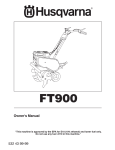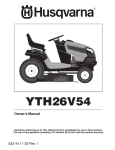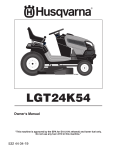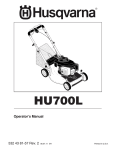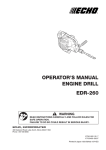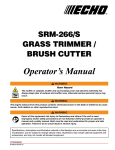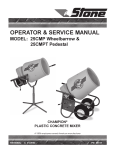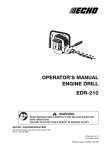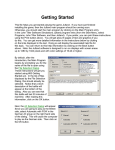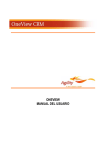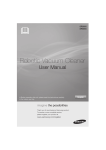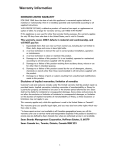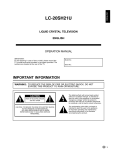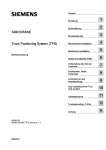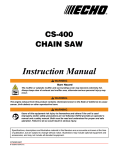Download Husqvarna HU800BBC User's Manual
Transcript
HU800BBC
Operator’s Manual
532 43 85-53 Rev. 2
06.08.11 BY
Printed in U.S.A.
SAFETY RULES
Safe Operation Practices for Walk-Behind Mowers
IMPORTANT: THIS CUTTING MACHINE IS CAPABLE OF AMPUTATING HANDS AND FEET AND THROWING OBJECTS. FAILURE
TO OBSERVE THE FOLLOWING SAFETY INSTRUCTIONS COULD RESULT IN SERIOUS INJURY OR DEATH.
•
Look for this symbol to point out important safety precautions. It means
CAUTION!!! BECOME ALERT!!! YOUR
SAFETY IS INVOLVED.
•
•
CAUTION: Always disconnect spark plug
wire and place wire where it cannot contact
spark plug in order to prevent accidental
starting when setting up, transporting,
adjusting or making repairs.
•
•
•
WARNING: Engine exhaust, some of its
constituents, and certain vehicle components contain or emit chemicals known to
the State of California to cause cancer and
birth defects or other reproductive harm.
•
•
•
WARNING: Battery posts, terminals and
related accessories contain lead and lead
compounds, chemicals known to the State
of California to cause cancer and birth
defects or other reproductive harm. Wash
hands after handling.
II. SLOPE OPERATION
Slopes are a major factor related to slip and fall accidents
which can result in severe injury. All slopes require extra
caution. If you feel uneasy on a slope, do not mow it.
DO:
• Mow across the face of slopes: never up and down. Exercise extreme caution when changing direction on slopes.
• Remove obstacles such as rocks, tree limbs, etc.
• Watch for holes, ruts, or bumps. Tall grass can hide
obstacles.
DO NOT:
• Do not trim near drop-offs, ditches or embankments.
The operator could lose footing or balance.
• Do not trim excessively steep slopes.
• Do not mow on wet grass. Reduced footing could cause
slipping.
CAUTION: Muffler and other engine parts
become extremely hot during operation
and remain hot after engine has stopped.
To avoid severe burns on contact, stay away
from these areas.
I. GENERAL OPERATION
•
•
•
•
•
•
•
•
•
•
Read, understand, and follow all instructions on the
machine and in the manual(s) before starting. Be thoroughly familiar with the controls and the proper use of
the machine before starting.
Do not put hands or feet near or under rotating parts.
Keep clear of the discharge opening at all times.
Only allow responsible individuals, who are familiar
with the instructions, to operate the machine.
Clear the area of objects such as rocks, toys, wire,
bones, sticks, etc., which could be picked up and thrown
by the blade.
Be sure the area is clear of other people before mowing. Stop machine if anyone enters the area.
Do not operate the mower when barefoot or wearing
open sandals. Always wear substantial foot wear.
Do not pull mower backwards unless absolutely necessary. Always look down and behind before and while
moving backwards.
Never direct discharged material toward anyone.
Avoid discharging material against a wall or obstruction. Material may richochet back toward the operator.
Stop the blade when crossing gravel surfaces.
Do not operate the mower without proper guards,
plates, grass catcher or other safety protective devices
in place.
See manufacturer’s instructions for proper operation
and installation of accessories. Only use accessories
approved by the manufacturer.
Stop the blade(s) when crossing gravel drives, walks,
or roads.
Stop the engine (motor) whenever you leave the equipment, before cleaning the mower or unclogging the
chute.
Shut the engine (motor) off and wait until the blade comes
to complete stop before removing grass catcher.
Mow only in daylight or good artificial light.
Do not operate the machine while under the influence
of alcohol or drugs.
Never operate machine in wet grass. Always be sure of
your footing: keep a firm hold on the handle and walk;
never run.
Disengage the self-propelled mechanism or drive clutch
on mowers so equipped before starting the engine (motor).
If the equipment should start to vibrate abnormally,
stop the engine (motor) and check immediately for the
cause. Vibration is generally a warning of trouble.
Always wear safety goggles or safety glasses with side
shields when operating mower.
III. CHILDREN
Tragic accidents can occur if the operator is not alert to
the presence of children. Children are often attracted to
the machine and the mowing activity. Never assume that
children will remain where you last saw them.
• Keep children out of the trimming area and under the
watchful care of another responsible adult.
• Be alert and turn machine off if children enter the
area.
• Before and while walking backwards, look behind and
down for small children.
• Never allow children to operate the machine.
• Use extra care when approaching blind corners, shrubs,
trees, or other objects that may obscure vision.
IV. SAFE HANDLING OF GASOLINE
2
Use extreme care in handling gasoline. Gasoline is extremely flammable and the vapors are explosive.
• Extinguish all cigarettes, cigars, pipes and other sources
of ignition.
• Use only an approved container.
• Never remove gas cap or add fuel with the engine running. Allow engine to cool before refueling.
•
•
•
•
•
•
•
Never refuel the machine indoors.
Never store the machine or fuel container where there
is an open flame, spark or pilot light such as a water
heater or on other appliances.
Never fill containers inside a vehicle, on a truck or trailer
bed with a plastic liner. Always place containers on
the ground away from your vehicle before filling.
Remove gas-powered equipment from the truck or trailer
and refuel it on the ground. If this is not possible, then
refuel such equipment with a portable container, rather
than from a gasoline dispenser nozzle.
Keep the nozzle in contact with the rim of the fuel tank
or container opening at all times until fueling is complete.
Do not use a nozzle lock-open device.
If fuel is spilled on clothing, change clothing immediately.
Never overfill fuel tank. Replace gas cap and tighten
securely.
•
•
•
•
•
•
•
V. GENERAL SERVICE
•
•
•
Never run a machine inside a closed area.
Never make adjustments or repairs with the engine
(motor) running. Disconnect spark plug wire, and keep
•
wire away from plug to prevent accidental starting.
Keep nuts and bolts, especially blade attachement
bolts, tight and keep equipment in good condition.
Never tamper with safety devices. Check their proper
operation regularly.
Keep machine free of grass, leaves, or other debris
build-up. Clean oil or fuel spillage. Allow machine to
cool before storing.
Stop and inspect the equipment if you strike an object.
Repair, if necessary, before restarting.
Never attempt to make wheel height adjustments while
the engine (motor) is running.
Grass catcher components are subject to wear, damage, and deterioration, which could expose moving
parts or allow objects to be thrown. Frequently check
components and replace with manufacturer’s recommended parts, when necessary.
Mower blade is sharp and can cut. Wrap the blade or
wear gloves, and use extra caution when servicing it.
Do not change the engine governor setting or overspeed
the engine.
Maintain or replace safety and instruction labels, as
necessary.
WARNING: This lawn mower is equipped with an internal combustion engine and should not be used on or near any
unimproved forest-covered, brush-covered or grass-covered land unless the engine’s exhaust system is equipped with
a spark arrester meeting applicable local or state laws (if any). If a spark arrester is used, it should be maintained in
effective working order by the operator.
A spark arrester for the muffler is available through your nearest authorized service center.
CONGRATULATIONS on your purchase of a new lawn
mower. It has been designed, engineered and manufactured
to give you the best possible dependability and performance.
Should you experience any problem you cannot easily
remedy, please contact your nearest authorized service
center/department. We have competent, well-trained
technicians and the proper tools to service or repair this
lawn mower.
Please read and retain this manual. The instructions will
enable you to assemble and maintain your lawn mower
properly. Always observe the “SAFETY RULES”.
PRODUCT SPECIFICATIONS
SERIAL
NUMBER: _________________________________
DATE OF PURCHASE: _______________________
Gasoline Capacity
and Type:
1.0 Quarts
(Unleaded Regular Only)
Oil Type (API SG–SL):
SAE 30 (above 0°C / 32°F)
SAE 10W-30 (below 0°C / 32°F)
Oil Capacity:
0,57 Litres
Spark Plug:
NGK BPR6ES (Gap: .030")
Valve Clearance:
(± 0.04 mm)
Intake: 0.015 mm
Exhaust: 0.020 mm
Blade Bolt Torque:
35–40 ft. lbs.
CUSTOMER RESPONSIBILITIES
THE MODEL AND SERIAL NUMBERS WILL BE FOUND
ON A DECAL ATTACHED TO THE REAR OF THE LAWN
MOWER HOUSING.
•
•
YOU SHOULD RECORD BOTH SERIAL NUMBER AND
DATE OF PURCHASE AND KEEP IN A SAFE PLACE
FOR FUTURE REFERENCE.
•
Read and observe the safety rules.
Follow a regular schedule in maintaining, caring for
and using your lawn mower.
Follow the instructions under “Maintenance” and “Storage” sections of this owner’s manual.
TABLE OF CONTENTS
SAFETY RULES ......................................................... 2-3
PRODUCT SPECIFICATIONS ....................................... 3
CUSTOMER RESPONSIBILITIES................................. 3
ASSEMBLY .................................................................... 4
OPERATION ............................................................. 5-10
MAINTENANCE SCHEDULE ...................................... 11
MAINTENANCE ...................................................... 11-14
SERVICE AND ADJUSTMENTS ................................. 15
STORAGE ............................................................... 15-16
TROUBLESHOOTING ................................................. 17
WARRANTY ............................................................ 18-21
3
ASSEMBLY
Read these instructions and this manual in its entirety before you attempt to assemble or operate your new lawn mower.
IMPORTANT: THIS LAWN MOWER IS SHIPPED WITHOUT OIL OR GASOLINE IN THE ENGINE.
Your new lawn mower has been assembled at the factory with the exception of those parts left unassembled for shipping
purposes. All parts such as nuts, washers, bolts, etc., necessary to complete the assembly have been placed in the parts
bag. To ensure safe and proper operation of your lawn mower, all parts and hardware you assemble must be tightened
securely. Use the correct tools as necessary to ensure proper tightness.
TO REMOVE LAWN MOWER FROM CARTON
Your handles may be adjusted for your mowing comfort.
Refer to “ADJUST HANDLE” in the Service and Adjustments
section of this manual.
1. Remove loose parts included with mower.
2. Cut down two end corners of carton and lay end panel
down flat.
3. Remove all packing materials except padding between
upper and lower handle and padding holding operator
presence control bar to upper handle.
4. Roll lawn mower out of carton and check carton thorougly for additional loose parts.
BOLT
KNOB
HANDLE
BRACKET
HOW TO SET UP YOUR LAWN MOWER
TO UNFOLD HANDLE (See Figs. 1 and 2)
IMPORTANT: UNFOLD HANDLE CAREFULLY SO AS
NOT TO PINCH OR DAMAGE CONTROL CABLES.
1. Raise lower handle section to operating position and
align hole in handle with one of three height positioning
holes.
2. Insert handle bolt through handle and bracket and
secure with knob.
3. Repeat for opposite side of handle.
4. Remove protective padding, raise upper handle section into place on lower handle and tighten both handle
knobs.
5. Remove any packing material from around control
bar.
OPERATOR
PRESENCE
CONTROL
BAR
FIG. 2
TO ASSEMBLE GRASS CATCHER
(See Fig. 3)
1. Put grass catcher frame into grass bag with rigid part
of bag on the bottom. Make sure the frame handle is
outside of the bag top.
2. Slip vinyl bindings over frame.
NOTE: If vinyl bindings are too stiff, hold them in warm water
for a few minutes. If bag gets wet, let it dry before using.
MOWING
POSITION
FRAME
HANDLE
LIFT
UP
LIFT
UP
UPPER
HANDLE
HANDLE
KNOB
FRAME
OPENING
VINYL
BINDINGS
FIG. 3
TO INSTALL ATTACHMENTS
LOWER
HANDLE
FIG. 1
Your lawn mower was shipped ready to be used as a
mulcher. To convert mower to bagging or discharging,
see “TO CONVERT MOWER” in the Operation section of
this manual.
4
OPERATION
KNOW YOUR LAWN MOWER
READ THIS OWNER'S MANUAL AND SAFETY RULES BEFORE OPERATING YOUR LAWN MOWER.
Compare the illustrations with your lawn mower to familiarize yourself with the location of various controls and adjustments.
Save this manual for future reference.
These symbols may appear on your lawn mower or in literature supplied with the product. Learn and understand
their meaning.
OPERATOR PRESENCE CONTROL BAR
DRIVE CONTROL
LEVERS
BLADE BRAKE/CLUTCH CONTROL
THROTTLE/ENGINE CONTROL
HANDLE KNOBS
GASOLINE FILLER CAP
FUEL SHUTOFF VALVE
STARTER
HANDLE
AIR FILTER
GRASS
CATCHER
SINGLE POINT HEIGHT
ADJUSTER LEVER
ENGINE OIL CAP WITH DIPSTICK
HOUSING
IMPORTANT: This lawn mower is shipped
MUFFLER
WITHOUT OIL OR GASOLINE in the engine.
SPARK PLUG
NOTE: Gasoline containing up to 10% ethanol (E10) is acceptable for use in this machine.
The use of any gasoline exceeding 10% ethanol (E10) will void the product warranty.
MEETS CPSC SAFETY REQUIREMENTS
Husqvarna rotary walk-behind power lawn mowers conform to the safety standards of the American National Standards
Institute and the U.S. Consumer Product Safety Commission.
OPERATOR PRESENCE CONTROL BAR – must be
held down to the handle to start the blade. Release to
stop the blade.
DRIVE CONTROL LEVERS – used to engage power-propelled forward motion lawn mower.
STARTER HANDLE – used for starting the engine.
5
BLADE BRAKE/CLUTCH CONTROL – used to engage
the blade after the engine is started.
THROTTLE/ENGINE CONTROL – used for starting
& stopping the engine; and allows you to select either
FAST or SLOW engine speed.
SINGLE POINT HEIGHT ADJUSTER – used to adjust
cutting height of lawn mower.
OPERATION
The operation of any lawn mower can result in foreign objects thrown into the eyes, which can result in
severe eye damage. Always wear safety glasses or eye shields while operating your lawn mower or performing any adjustments or repairs. We recommend standard safety glasses or a wide vision safety mask
over spectacles.
HOW TO USE YOUR LAWN MOWER
CAUTION: Federal regulations require
this blade/brake control to minimize the
risk of blade contact injury. Do not under any circumstances attempt to defeat
the function of this control.
THROTTLE / ENGINE CONTROL (See Fig. 4)
The engine is controlled by a throttle control located on the
side of the upper handle. CHOKE position is for starting a
cold engine; FAST position is for starting a warm engine,
normal cutting, trimming and better grass bagging; SLOW
position is for light cutting, trimming and fuel economy, and
STOP position is for stopping the engine.
FAST
SLOW
OPERATOR
PRESENCE
CONTROL
BAR
STOP
CHOKE
TO ENGAGE BLADE
BLADE/
BRAKE
CONTROL
FIG. 4
BLADE DISENGAGED
BLADE CONTROL (See Fig. 5)
FIG. 5
CAUTION: When the blade control is
engaged, the blade turns.
ENGINE ZONE CONTROL
•
To start the blade, hold the operator presence control
bar down to the handle and push the blade/brake control lever forward until it latches. To stop the blade,
release the operator presence control bar. Do not
pull the blade/brake lever rearward with the operator
presence control bar down against the handle. Allow
a cold engine to warm up in high idle position for one
minute before engaging the blade.
NOTE: It is normal to hear the belt slip as the blade is
engaged and comes up to speed.
• Do not start the blade in uncut grass. Move the mower
out of uncut grass before starting the blade.
CAUTION: Federal regulations require
an engine control to be installed on this
lawn mower in order to minimize the risk
of blade contact injury. Do not under
any circumstances attempt to defeat
the function of the operator control. The
blade turns when the engine is running.
•
6
Your lawn mower is equipped with an operator presence
control bar which requires the operator to be positioned
behind the mower handle to start and operate the mower.
OPERATION
DRIVE CONTROL (See Fig. 6)
NOTE: If condition fails to improve after the above steps
(forward speed remains the same), your drive belt is worn
and should be replaced.
•
Self-propelling is controlled by holding the operator
presence control bar down to the handle and pulling
either drive control lever rearward to the handle. The
further toward the handle a lever is pulled, the faster
the unit will travel.
• To stop forward motion without stopping blade, release
a drive control lever. Hold operator presence control
bar down against handle to continue mowing without
self-propelling.
NOTE: If after releasing the drive control the mower will
not roll backwards, push the mower forward slightly to
disengage drive wheels.
ADJUSTMENT
TURNBUCKLE
FIG. 7
TO ADJUST CUTTING HEIGHT (See Fig. 8)
All four wheels are adjusted by a single lever.
• Pull adjuster lever toward wheel. To raise mower, move
lever forward to desired position. To lower mower, move
the lever toward the rear.
OPERATOR
PRESENCE
CONTROL BAR
WHEEL
ADJUSTER
LEVER
TO ENGAGE DRIVE CONTROL
LEVER BACKWARD
TO LOWER MOWER
DRIVE
CONTROL
LEVERS
DRIVE CONTROL DISENGAGED
LEVER FORWARD
TO RAISE MOWER
FIG. 6
DRIVE CONTROL ADJUSTMENT (See Fig. 7)
FIG. 8
Over time, the drive control system may become “loose”,
resulting in decreased speed. There is a turnbuckle on
the drive control housing to increase tension on the drive
cable. Proceed as follows:
1. Turn unit off and disconnect spark plug wire from spark
plug.
2. Rotate turnbuckle on drive control to increase drive
speed.
3. Operate mower to test drive speed. Readjust as required.
7
OPERATION
TO CONVERT MOWER
CAUTION: Do not run your lawn mower
without rear door closed or approved
grass catcher or clipping deflector in
place. Never attempt to operate the lawn
mower with the rear door removed or
propped open.
Your lawn mower was shipped ready to be used as a
mulcher. To convert to bagging:
REAR BAGGING (See Fig. 9)
• Lift rear door of the lawn mower and place the grass
catcher frame hooks onto the grass bag brackets.
• To convert to mulching operation, remove grass catcher
and close rear door.
TO EMPTY GRASS CATCHER (See Fig. 11)
1. Lift up on grass catcher using the frame handle.
2. Remove grass catcher with clippings from under lawn
mower handle.
3. Empty clippings from bag using both frame handle and
bag handle.
NOTE: Do not drag the bag when emptying; it will cause
unnecessary wear.
REAR DOOR
GRASS BAG
BRACKET
GRASS
CATCHER
HANDLE
GRASS
CATCHER
FRAME
HANDLE
GRASS
CATCHER
FRAME HOOK
FIG. 9
REAR DISCHARGING (See Fig. 10)
• Lift the rear door and install the clipping deflector (available accessory) legs into holes of handle brackets as
shown.
• When the rear door is lowered it will rest on the top
of the clipping deflector and secure it to the mower
housing.
• Mower is now ready for rear discharging operation.
• To convert to mulching or bagging operation, clipping
deflector must be removed and mulcher door must be
closed and locked.
BAG
HANDLE
FIG. 11
BEFORE STARTING ENGINE
ADD OIL (See Fig. 12)
Your lawnmower is shipped without oil in the engine. For
type and grade of oil to use, see “ENGINE” in the Maintenance section of this manual.
HANDLE
BRACKET
HOLES
CAUTION: DO NOT overfill engine with
oil, or it will smoke heavily from the
muffler on startup.
REAR
DOOR
1. Be sure lawnmower is level.
2. Remove oil fill cap/dipstick from oil fill spout.
3. You recieve a container of oil with the unit. Slowly
pour the entire container down the oil fill spout into the
engine.
4. Insert and tighten oil fill cap/dipstick.
DEFLECTOR
BAR “LEG”
IMPORTANT:
•
•
CLIPPING DEFLECTOR
FIG. 10
8
Check oil level before each use. Add oil if needed. Fill
to full line on dipstick.
Change the oil after every 25 hours of operation or each
season. You may need to change the oil more often under dusty, dirty conditions. See “TO CHANGE ENGINE
OIL” in the Maintenance section of this manual.
OPERATION
GASOLINE
FILLER CAP
FAST
SLOW
STOP
CHOKE
ENGINE
OIL CAP
FIG. 12
ADD GASOLINE (See Fig. 12)
•
Fill fuel tank to bottom of tank filler neck. Do not overfill. Use fresh, clean, regular unleaded gasoline with
a minimum of 87 octane. Do not mix oil with gasoline.
Purchase fuel in quantities that can be used within 30
days to assure fuel freshness.
FIG. 13
TO START ENGINE (See Figs. 13 & 14)
NOTE: Due to protective coatings on the engine, a small
amount of smoke may be present during the initial use of
the product and should be considered normal.
1. Be sure fuel valve is in the ON position.
2. To start a cold engine, move handle mounted throttle/
choke control lever to CHOKE position.
3. Hold operator presence control bar down to the
handle.
4. To start engine, pull starter handle quickly. Do not allow
starter rope to snap back.
5. Slowly move throttle control lever to FAST position
after engine starts.
• To start a warm engine, move throttle control lever to
FAST position, then follow steps above.
NOTE: Allow a cold engine to warm up for one minute
before starting the blade. See “BLADE CONTROL” in this
section of this manual.
CAUTION: Wipe off any spilled oil or
fuel. Do not store, spill or use gasoline
near an open flame.
CAUTION: Alcohol blended fuels
(called gasohol or using ethanol or
methanol) can attract moisture which
leads to separation and formation of
acids during storage. Acidic gas can
damage the fuel system of an engine
while in storage. To avoid engine
problems, the fuel system should be
emptied before storage of 30 days or
longer. Empty the gas tank, start the
engine and let it run until the fuel lines
and carburetor are empty. Use fresh fuel
next season. See Storage Instructions
for additional information. Never use
engine or carburetor cleaner products
in the fuel tank or permanent damage
may occur.
OFF
TO STOP ENGINE (See Fig. 13)
•
ON
(
To stop engine, move throttle control lever to STOP
position. Wait until blade and all moving parts have
stopped and turn fuel valve to OFF position if you do
not intend to restart the engine soon.
CHOKE
LEVER
)
OFF
ON
FUEL VALVE LEVER
FIG. 14
9
OPERATION
MULCHING MOWING TIPS
MOWING TIPS
IMPORTANT: FOR BEST PERFORMANCE, KEEP MOWER
HOUSING FREE OF BUILT-UP GRASS AND TRASH. SEE
“CLEANING” IN THE MAINTENANCE SECTION OF THIS
MANUAL.
CAUTION: Do not use de-thatcher
blade attachments on your mower.
Such attachments are hazardous, will
damage your mower and could void
your warranty.
•
•
•
•
•
•
•
•
Under certain conditions, such as very tall grass, it
may be necessary to raise the height of cut to reduce
pushing effort and to keep from overloading the engine
and leaving clumps of grass clippings. It may also be
necessary to reduce ground speed and/or run the lawn
mower over the area a second time.
For extremely heavy cutting, reduce the width of cut
by overlapping previously cut path and mow slowly.
For better grass bagging and most cutting conditions,
the engine speed should be set in the FAST position.
When using a rear discharge lawn mower in moist,
heavy grass, clumps of cut grass may not enter the
grass catcher. Reduce ground speed (pushing speed)
and/or run the lawn mower over the area a second
time.
If a trail of clippings is left on the right side of a rear
discharge mower, mow in a clockwise direction with
a small overlap to collect the clippings on the next
pass.
Pores in cloth grass catchers can become filled with
dirt and dust with use and catchers will collect less
grass. To prevent this, regularly hose catcher off with
water and let dry before using.
Keep top of engine around starter clear and clean of
grass clippings and chaff. This will help engine air flow
and extend engine life.
•
•
The special mulching blade will recut the grass clippings many times and reduce them in size so that as
they fall onto the lawn they will disperse into the grass
and not be noticed. Also, the mulched grass will biodegrade quickly to provide nutrients for the lawn. Always
mulch with your highest engine (blade) speed as this
will provide the best recutting action of the blades.
Avoid cutting your lawn when it is wet. Wet grass tends
to form clumps and interferes with the mulching action.
The best time to mow your lawn is the early afternoon.
At this time the grass has dried, yet the newly cut area
will not be exposed to direct sunlight.
For best results, adjust the lawn mower cutting height
so that the lawn mower cuts off only the top one-third
of the grass blades (See Fig. 15). If the lawn is overgrown it will be necessary to raise the height of cut to
reduce pushing effort and to keep from overloading
the engine and leaving clumps of mulched grass. For
extremely heavy mulching, reduce your width of cut by
overlapping previously cut path and mow slowly.
MAX 1/3
FIG. 15
•
•
10
Certain types of grass and grass conditions may require
that an area be mulched a second time to completely
hide the clippings. When doing a second cut, mow
across (perpendicular) to the first cut path.
Change your cutting pattern from week to week. Mow
north to south one week then east to west the next
week. This will help prevent matting and graining of
the lawn.
MAINTENANCE
BEFORE
EACH
USE
AFTER
EACH
USE
EVERY
10
HOURS
EVERY
25 HOURS
OR SEASON
EVERY
100
HOURS
BEFORE
STORAGE
Check for Loose Fasteners
Clean / Inspect Grass Catcher *
Check Tires
Check Drive Wheels ***
Clean Lawn Mower ****
Clean under Drive Cover ***
Check Drive Belt / Pulleys ***
Check / Sharpen / Replace Blade
Lubrication
Clean and Recharge Battery **
Check Engine Oil level
Change Engine Oil
Clean Air Filter
Inspect Muffler
Replace Spark Plug
Replace Air Filter Paper Cartridge
Empty fuel system or add Stabilizer
* (if so equipped)
** Electric-Start mowers
*** Power-Propelled mowers
a scraper
**** Use
to clean under deck
1 - Change more often if operating under a heavy load or in high outdoor temperatures.
2 - Service more often if operating in dirty or dusty conditions.
3 - Replace blades more often when mowing in sandy soil.
4 - Charge 48 hours at end of season.
5 - And after each 5 hours of use.
GENERAL RECOMMENDATIONS
LUBRICATION CHART
The warranty on this lawn mower does not cover items that
have been subjected to operator abuse or negligence. To
receive full value from the warranty, operator must maintain
mower as instructed in this manual. Some adjustments
will need to be made periodically to properly maintain your
unit. At least once a season, check to see if you should
make any of the adjustments described in the Service and
Adjustments section of this manual.
• At least once a year, replace the spark plug, clean or
replace air filter element and check blade for wear. A
new spark plug and clean/new air filter element assure
proper air-fuel mixture and help your engine run better
and last longer.
• Follow the maintenance schedule in this manual.
ENGINE OIL
BEFORE EACH USE
REAR DOOR HINGE
1. Check engine oil level.
2. Check for loose fasteners.
LUBRICATION
Keep unit well lubricated (See “LUBRICATION CHART”).
IMPORTANT: DO NOT OIL OR GREASE PLASTIC WHEEL
BEARINGS. VISCOUS LUBRICANTS WILL ATTRACT DUST
AND DIRT THAT WILL SHORTEN THE LIFE OF THE SELFLUBRICATING BEARINGS. IF YOU FEEL THEY MUST BE
LUBRICATED, USE ONLY A DRY, POWDERED GRAPHITE
TYPE LUBRICANT SPARINGLY.
HANDLE BRACKET MOUNTING PINS
SPRAY LUBRICANT
SEE “ENGINE” IN MAINTENANCE SECTION
11
MAINTENANCE
LAWN MOWER
Always observe safety rules when performing any maintenance.
TIRES
•
•
Keep tires free of gasoline, oil, or insect control chemicals which can harm rubber.
Avoid stumps, stones, deep ruts, sharp objects and
other hazards that may cause tire damage.
TRAILING EDGE
DEBRIS
SHIELD
DRIVE WHEELS
Check rear drive wheels each time you mow to be sure they
move freely. The wheels not turning freely means trash,
grass cuttings, etc., may be inside the drive wheel and dust
cover area and must be cleaned out to free drive wheels.
If necessary to clean drive wheels, check both rear wheels.
BLADE
ADAPTER
BLADE
BLADE BOLTS
BLADE CARE (See Fig. 15)
FIG. 15
For best results, mower blade must be kept sharp. Replace
a bent or damaged blade.
TO SHARPEN BLADE
NOTE: We do not recommend sharpening blade - but if you
do, be sure the blade is balanced. An unbalanced blade
will cause eventual damage to lawn mower or engine.
• The blade can be sharpened with a file or on a grinding wheel. Do not attempt to sharpen while on the
mower.
• To check blade balance, drive a nail into a beam or
wall. Leave about one inch of the straight nail exposed.
Place center hole of blade over the head of the nail.
If blade is balanced, it should remain in a horizontal
position. If either end of the blade moves downward,
sharpen the heavy end until the blade is balanced.
CAUTION: Use only a replacement
blade approved by the manufacturer of
your mower. Using a blade not approved
by the manufacturer of your mower is
hazardous, could damage your mower
and void your warranty.
TO REMOVE BLADE
1. Disconnect spark plug wire from spark plug and place
wire where it cannot come in contact with plug.
2. Turn lawn mower on its side. Make sure air filter and
carburetor are up.
3. Use a wood block between blade and mower housing
to prevent blade from turning when removing blade
bolt.
NOTE: Protect your hands with gloves and/or wrap blade
with heavy cloth.
4. Remove blade bolts by turning counter-clockwise.
5. Remove blade and blade adapter.
6. Remove debris shield.
TO REPLACE BLADE
1. Install debris shield.
2. Position the blade and blade adapter on the Blade/Brake
Clutch.
3. Be sure the trailing edge of blade (opposite sharp edge)
is up toward the engine.
4. Install the blade bolts into blade adapter and Blade/
Brake Clutch.
5. Use block of wood between blade and lawn mower housing and tighten the blade bolts, turning clockwise.
• The recommended tightening torque is 36–44 ft. lbs.
IMPORTANT: Blade bolts are heat treated. If bolts need
replacing, replace only with approved bolts.
GRASS CATCHER
•
•
The grass catcher may be hosed with water, but must
be dry when used.
Check your grass catcher often for damage or deterioration. Through normal use it will wear. If catcher
needs replacing, replace only with approved replacement catcher shown in the Repair Parts section of this
manual. Give the lawn mower model number when
ordering.
GEAR CASE
•
•
12
To keep your drive system working properly, the gear
case and area around the drive should be kept clean
and free of trash build-up. Clean under the drive cover
twice a season.
The gear case is filled with lubricant to the proper level
at the factory. The only time the lubricant needs attention is if service has been performed on the gear case.
MAINTENANCE
ENGINE
4. Wipe off any spilled oil from lawn mower or side of
engine.
5. Fill engine with oil. Slowly pour oil down the oil fill spout
into the engine.
6. Wait one minute to allow oil to settle. Use guage on oil
fill cap/dipstick for checking level. Insert dipstick into
the tube and rest the oil fill cap on the tube. DO NOT
thread the cap into the tube when taking reading.
LUBRICATION
Maintenance, repair, or replacement of the emission control
devices and systems, which are being done at the customers expense, may be performed by any non-road engine
repair establishment or individual. Warranty repairs must
be performed by an authorized engine manufacturer’s
service outlet.
LUBRICATION
OIL FILL CAP /
DIPSTICK
Use only high quality detergent oil rated with API service
classification SG–SL. Select the oil's SAE viscosity grade
according to your expected operating temperature.
UPPER
MARK
LOWER MARK
NOTE: Multi-viscosity oils (5W30, 10W30 etc.) improve
starting in cold weather, and you should check your engine
oil level frequently to avoid possible engine damage from
running low on oil.
Change the oil after every 25 hours of operation or at least
once a year if the lawn mower is not used for 25 hours in
one year.
Check the crankcase oil level before starting the engine
and after each five (5) hours of continuous use. Tighten oil
plug securely each time you check the oil level.
FIG. 17
7. Continue adding small amounts of oil and rechecking
the dipstick until it reads full. DO NOT overfill, or engine
will smoke on startup.
8. Always be sure to retighten oil fill cap/dipstick before
starting engine.
9. Reconnect spark plug wire to spark plug.
AIR FILTER (See Fig. 18)
TO CHANGE ENGINE OIL (See Figs. 16 & 17)
Your engine will not run properly and may be damaged by
using a dirty air filter. Replace the air filter every 100 hours of
operation or every season, whichever occurs first. Service
air cleaner more often under dusty conditions.
NOTE: Before tipping lawn mower to drain oil, empty fuel
tank by running engine until fuel tank is empty.
1. Disconnect spark plug wire from spark plug and place
wire where it cannot come in contact with plug.
2. Remove oil fill cap/dipstick; lay aside on a clean surface.
3. Tip lawn mower on its side as shown and drain oil into
a suitable container. Rock lawn mower back and forth
to remove any oil trapped inside of engine.
TO CLEAN AIR FILTER
1. Remove cover.
2. Carefully remove cartridge.
3. Clean by gently tapping on a flat surface. If very dirty,
replace cartridge.
CAUTION: Petroleum solvents, such as
kerosene, are not to be used to clean
cartridge. They may cause deterioration
of the cartridge. Do not oil cartridge.
Do not use pressurized air to clean or
dry cartridge.
4. Install cartridge, then replace cover.
CONTAINER
FIG. 16
13
MAINTENANCE
WATER WASHOUT FEATURE (See Fig. 19)
Your lawn mower is equipped with a fitting that allows quick
and easy cleaning of the underside of the housing. To use
this feature, proceed as follows:
1. Move lawn mower to an area of cut grass or another
hard surface.
NOTE: Water, grass and other debris will drain from beneath
the mower housing during the washout process.
2. Remove grass catcher and discharge chute assembly
from lawn mower.
3. Close mulcher door (if equipped).
4. Connect a garden hose to the fitting where shown.
SLOT
TAB
IMPORTANT: BE SURE THE GARDEN HOSE IS NOT ROUTED
UNDER THE LAWN MOWER HOUSING OR ENTANGLED IN
THE WHEELS.
CARTRIDGE
5. Turn on water supply and check for leaks at the fitting.
If no leaks are present, start engine (as described in the
Operation section of this manual) and let engine run until
the underside of the lawn mower is clean.
FILTER COVER
FIG. 18
WARNING: Do not engage the drive
system during the washout process.
MUFFLER
6. Shut off the engine.
7. Shut off water supply and remove hose from fitting.
Inspect and replace corroded muffler as it could create a
fire hazard and/or damage.
CAUTION: Do not remove hose from
fitting while engine is running. Water
in engine can result in shortened engine life.
SPARK PLUG
Replace spark plug at the beginning of each mowing season
or after every 100 hours of operation, whichever occurs
first. Spark plug type and gap setting are shown in the
“PRODUCT SPECIFICATIONS” section of this manual.
8. Start engine (as described in the Operation section
of this manual) and let engine run for a full minute to
remove excess water from mower.
CLEANING
HOSE
IMPORTANT: FOR BEST PERFORMANCE, KEEP MOWER
HOUSING FREE OF BUILT-UP GRASS AND TRASH. CLEAN
THE UNDERSIDE OF YOUR MOWER AFTER EACH USE.
CAUTION: Disconnect spark plug wire
from spark plug and place wire where it
cannot come in contact with plug.
•
•
•
•
Clean the underside of your lawn mower by scraping
to remove build-up of grass and trash.
Clean engine often to keep trash from accumulating. A
clogged engine runs hotter and shortens engine life.
Keep finished surfaces / wheels free of gasoline, oil, etc.
We do not recommend using a garden hose to clean
lawn mower unless the electrical system, muffler, air
filter and carburetor are covered to keep water out.
Water in engine can result in shortened engine life.
FITTING
FIG. 19
14
SERVICE AND ADJUSTMENTS
CAUTION: TO AVOID SERIOUS INJURY,
BEFORE PERFORMING ANY SERVICE OR
ADJUSTMENTS:
1. Release control bar and stop engine.
2. Make sure the blade and all moving
parts have completely stopped.
3. Disconnect spark plug wire from
spark plug and place where it cannot come in contact with plug.
BOLT
KNOB
HANDLE
BRACKET
LAWN MOWER
TO ADJUST CUTTING HEIGHT
See “TO ADJUST CUTTING HEIGHT” in the Operation
section of this manual.
FIG. 20
ENGINE
REAR DEFLECTOR
Maintenance, repair, or replacement of the emission control devices and systems, which are being done at the
customers expense, may be performed by any non-road
engine repair establishment or individual. Warranty repairs
must be performed by an authorized engine manufacturer's
service outlet.
The rear deflector, attached between the rear wheels of
your mower, is provided to minimize the possibility that
objects will be thrown out of the rear of the mower into
the operator's mowing position. If the deflector becomes
damaged, it should be replaced.
ENGINE SPEED
TO REMOVE DRIVE BELT
Your engine speed has been factory set. Do not attempt to
increase engine speed or it may result in personal injury. If
you believe that the engine is running too fast or too slow,
take your lawn mower to an authorized service center for
repair and adjustment.
If your mower does not operate properly due to suspected
drive belt problems, take your mower to a qualified service
center for repair and/or adjustment.
TO ADJUST HANDLE (See Fig. 20)
CARBURETOR
The handle on your lawn mower has three (3) height positions - adjust to height that suits you.
1. Remove knob and carriage bolt on one side of the
lower handle.
2. While holding handle assembly, remove knob and
carriage bolt from opposite side, align hole in handle
with desired hole in handle bracket and reassemble
bolt and knob and tighten securely.
3. Align opposite side of handle with same positioning
hole and secure with bolt and knob.
Your carburetor is not adjustable. If your engine does not
operate properly due to suspected carburetor problems,
take your lawn mower to an authorized service center for
repair and/or adjustment.
IMPORTANT: NEVER TAMPER WITH THE ENGINE GOVERNOR,
WHICH IS FACTORY SET FOR PROPER ENGINE SPEED.
OVERSPEEDING THE ENGINE ABOVE THE FACTORY HIGH
SPEED SETTING CAN BE DANGEROUS. IF YOU THINK THE
ENGINE-GOVERNED HIGH SPEED NEEDS ADJUSTING,
CONTACT YOUR NEAREST AUTHORIZED SERVICE CENTER,
WHICH HAS PROPER EQUIPMENT AND EXPERIENCE TO
MAKE ANY NECESSARY ADJUSTMENTS.
STORAGE
Immediately prepare your mower for storage at the end
of the season or if the unit will not be used for 30 days or
more.
LAWN MOWER
When lawn mower is to be stored for a period of time, clean
it thoroughly, remove all dirt, grease, leaves, etc. Store in
a clean, dry area.
15
1. Clean entire lawn mower (See “CLEANING” in the
Maintenance section of this manual).
2. Lubricate as shown in the Maintenance section of this
manual.
3. Be sure that all nuts, bolts, screws, and pins are securely fastened. Inspect moving parts for damage,
breakage and wear. Replace if necessary.
4. Touch up all rusted or chipped paint surfaces; sand
lightly before painting.
STORAGE
HANDLE (See Figs. 21 and 22)
ENGINE
You can fold your lawn mower handle for storage.
1. Loosen the two (2) handle knobs on sides of the upper
handle and allow handle to fold down to the rear.
2. Remove the two (2) handle knobs and carriage bolts
on sides of the lower handle and pivot entire handle
assembly forward and allow it to rest on mower.
3. Reinstall knobs and carriage bolts to lower handle or
handle brackets for safe keeping.
• When setting up your handle from the storage position,
the lower handle will require manually locking into the
mowing position.
FUEL SYSTEM
IMPORTANT: IT IS IMPORTANT TO PREVENT GUM DEPOSITS
FROM FORMING IN ESSENTIAL FUEL SYSTEM PARTS
SUCH AS CARBURETOR, FUEL FILTER, FUEL HOSE, OR
TANK DURING STORAGE. ALCOHOL BLENDED FUELS
(CALLED GASOHOL OR USING ETHANOL OR METHANOL)
CAN ATTRACT MOISTURE WHICH LEADS TO SEPARATION
AND FORMATION OF ACIDS DURING STORAGE. ACIDIC GAS
CAN DAMAGE THE FUEL SYSTEM OF AN ENGINE WHILE IN
STORAGE.
•
Empty the fuel tank by starting the engine and letting
it run until the fuel lines and carburetor are empty.
• Never use engine or carburetor cleaner products in the
fuel tank or permanent damage may occur.
• Use fresh fuel next season.
NOTE: Fuel stabilizer is an acceptable alternative in minimizing the formation of fuel gum deposits during storage.
Add stabilizer to gasoline in fuel tank or storage container.
Always follow the mix ratio found on stabilizer container.
Run engine at least 10 minutes after adding stabilizer to
allow the stabilizer to reach the carburetor. Do not empty
the gas tank and carburetor if using fuel stabilizer.
IMPORTANT: WHEN FOLDING THE HANDLE FOR STORAGE
OR TRANSPORTATION, BE SURE TO FOLD THE HANDLE AS
SHOWN OR YOU MAY DAMAGE THE CONTROL CABLES.
MOWING
POSITION
OPERATOR
PRESENCE
CONTROL
BAR
FOLD
FORWARD
FOR
STORAGE
ENGINE OIL
Drain oil (with engine warm) and replace with clean engine oil. (See “ENGINE” in the Maintenance section of
this manual).
UPPER
HANDLE
CYLINDER
1. Remove spark plug.
2. Pour one ounce (29 ml) of oil through spark plug hole
into cylinder.
3. Pull starter handle slowly a few times to distribute oil.
4. Replace with new spark plug.
HANDLE
KNOB
LOWER
HANDLE
OTHER
•
•
•
FIG. 21
•
BOLT
KNOB
Do not store gasoline from one season to another.
Replace your gasoline can if your can starts to rust.
Rust and/or dirt in your gasoline will cause problems.
If possible, store your unit indoors and cover it to give
protection from dust and dirt.
Cover your unit with a suitable protective cover that
does not retain moisture. Do not use plastic. Plastic
cannot breathe, which allows condensation to form and
will cause your unit to rust.
IMPORTANT: NEVER COVER MOWER WHILE ENGINE AND
EXHAUST AREAS ARE STILL WARM.
HANDLE
BRACKET
CAUTION: Never store the lawn mower
with gasoline in the tank inside a building where fumes may reach an open
flame or spark. Allow the engine to cool
before storing in any enclosure.
FIG. 22
16
TROUBLESHOOTING POINTS
PROBLEM
Does not start
CAUSE
1. Dirty air filter.
2. Out of fuel.
3. Stale fuel.
4.
5.
6.
7.
8.
9.
10.
11.
12.
Loss of power
CORRECTION
1. Clean/replace air filter.
2. Fill fuel tank.
3. Empty fuel tank and refill tank with fresh,
clean gasoline.
Water in fuel.
4. Empty fuel tank and refill tank with fresh,
clean gasoline.
Spark plug wire is disconnected.
5. Connect wire to plug.
Bad spark plug.
6. Replace spark plug.
Loose blade or broken blade adapter.
7. Tighten blade bolt or replace blade adapter.
Control bar in released position.
8. Depress control bar to handle.
Control bar defective.
9. Replace control bar.
Fuel valve lever (if equipped) in OFF position. 10. Turn fuel valve lever to the ON position.
Weak battery (if equipped).
11. Charge battery.
Disconnected battery connector (if equipped). 12. Connect battery to engine.
1. Rear of lawn mower housing or cutting
blade dragging in heavy grass.
2. Cutting too much grass.
3. Dirty air filter.
4. Buildup of grass, leaves and trash under
mower.
5. Too much oil in engine.
6. Walking speed too fast.
1. Raise cutting height.
2. Raise cutting height.
3. Clean/replace air filter.
4. Clean underside of mower housing.
5. Check oil level.
6. Cut at slower walking speed.
Poor cut –
uneven
1. Worn, bent or loose blade.
2. Wheel heights uneven.
3. Buildup of grass, leaves and trash under
mower.
1. Replace blade. Tighten blade bolt.
2. Set all wheels at same height.
3. Clean underside of mower housing.
Excessive
vibration
1. Worn, bent or loose blade.
2. Bent engine crankshaft.
1. Replace blade. Tighten blade bolt.
2. Contact a qualified service center.
Starter rope
hard to pull
1. Engine flywheel brake is on when control
bar is released.
2. Bent engine crankshaft.
3. Blade adapter broken.
4. Blade dragging in grass.
1. Depress control bar to upper handle before
pulling starter rope.
2. Contact a qualified service center.
3. Replace blade adapter.
4. Move lawn mower to cut grass or other
hard surface before starting.
Grass catcher
1. Cutting height too low.
not filling
2. Lift on blade worn off.
(if so equipped) 3. Catcher not venting air.
1. Raise cutting height.
2. Replace blade.
3. Clean grass catcher.
Hard to push
1. Grass is too high or wheel height is too low.
2. Rear of lawn mower housing or cutting
blade dragging in heavy grass.
3. Grass catcher too full.
4. Handle height position not right for you.
1. Raise cutting height.
2. Raise rear of lawn mower housing one (1)
setting higher.
3. Empty grass catcher.
4. Adjust handle height to suit.
Loss of drive
(or slowing of
drive speed)
1.
2.
3.
4.
1.
2.
3.
4.
Belt wear.
Belt off of pulley.
Drive cable worn or broken.
“Loose” drive control system.
17
Check/replace drive belt.
Check/reinstall drive belt.
Put belt on pulleys / replace belts if broken.
Adjust drive control.
&RQVXPHU:KHHOHG3URGXFWV±/LPLWHG:DUUDQW\
+XVTYDUQDZDUUDQWVWRWKHRULJLQDOUHWDLOSXUFKDVHUWKDWWKLV+XVTYDUQDSURGXFWLVIUHHIURPGHIHFWVLQPDWHULDORUZRUNPDQVKLS
XQGHUQRUPDOXVHDQGPDLQWHQDQFHIURPWKHGDWHRIUHWDLOSXUFKDVHIRUWKHDSSOLFDEOH:DUUDQW\3HULRGVKRZQRQ([KLELW$&HUWDLQ
FRPSRQHQWVHJHQJLQHVDQGWUDQVPLVVLRQVDUHH[FOXGHGIURPFRYHUDJHDQGRWKHUOLPLWDWLRQVDSSO\DVGHVFULEHGLQWKLVGRFXPHQW
+XVTYDUQDZLOOUHSDLURUUHSODFHDWLWVGLVFUHWLRQDQ\GHIHFWLYHSURGXFWRUSDUWFRYHUHGE\WKH/LPLWHG:DUUDQW\IUHHRIFKDUJHDWDQ\
DXWKRUL]HG +XVTYDUQD 6HUYLFLQJ 'HDOHU&HQWHU XVLQJ RULJLQDO 2(0 +XVTYDUQD UHSODFHPHQW SDUWV VXEMHFW WR WKH OLPLWDWLRQV DQG
H[FOXVLRQVGHVFULEHGEHORZ+XVTYDUQDGRHVQRWRIIHUDQRYHUWKHFRXQWHUH[FKDQJHSURJUDP
7+,6 /,0,7(' :$55$17< ,6 7+( 62/( (;35(66 :$55$17< 3529,'(' %< +8649$51$ $1< :$55$17<
7+$7 0$< %( ,03/,(' %< /$: ,1&/8',1* $1< ,03/,(' :$55$17< 2) ),71(66 )25 $ 3$57,&8/$5
385326( 25 86( $1' ,03/,(' :$55$17< 2) 0(5&+$17$%,/,7< ,6 /,0,7(' 72 7+( '85$7,21 2) 7+(
$33/,&$%/( :$55$17< 3(5,2' 81'(5 7+,6 /,0,7(' :$55$17< 7+,6 /,0,7(' :$55$17< 0$< %(
02',),(' 21/< %< +8649$51$ 620( 67$7(6 '2 127 $//2: /,0,7$7,216 21 +2: /21* $1 ,03/,('
:$55$17< /$676 62 7+( $%29( /,0,7$7,216 0$< 127 $33/< 72 <28 7+,6 /,0,7(' :$55$17< *,9(6
<2863(&,),&/(*$/5,*+76$1'<280$<$/62+$9(27+(55,*+76:+,&+9$5<)52067$7(7267$7(
7+,6:$55$17<,6*,9(121/<%<+8649$51$7+($%29(5(0(',(6$5(7+((;&/86,9(5(0(',(6)25
$1< %5($&+ 2) 7+,6 /,0,7(' :$55$17< +8649$51$ $1' ,76 $)),/,$7(' &203$1,(6 6+$// 127 %(
/,$%/( )25 $1< 63(&,$/ ,1&,'(17$/ 25 &216(48(17,$/ '$0$*( ,1&/8',1* /267 352),76 5(68/7,1*
)520$1<68&+%5($&+$1'$//68&+'$0$*(6$5(+(5(%<',6&/$,0('620(67$7(6'2127$//2:
7+((;&/86,2125/,0,7$7,212),1&,'(17$/25&216(48(17,$/'$0$*(6627+($%29(/,0,7$7,216
0$<127$33/<72<28
/,0,7$7,216$1'(;&/86,216
(QJLQHV7UDQVPLVVLRQVDQGFHUWDLQRWKHUFRPSRQHQWVDUH127FRYHUHG 7KLV/LPLWHG:DUUDQW\GRHVQRWFRYHUDQ\RIWKH
IROORZLQJ
D (QJLQHVDQG$WWDFKPHQWV([FHSWZKHUHRWKHUZLVHLQGLFDWHGRQ([KLELW$DOO(QJLQHVDQG$WWDFKPHQWVDUHQRWFRYHUHGE\
WKLVZDUUDQW\,QPRVWFDVHVWKHVHLWHPVDUH127PDQXIDFWXUHGE\+XVTYDUQDLQZKLFKFDVHWKH\PD\EHFRYHUHGVHSDUDWHO\E\
WKHLU UHVSHFWLYH PDQXIDFWXUHU¶V ZDUUDQWLHV LI RQH LV SURYLGHG DQG LQFOXGHG ZLWK WKH SURGXFW DW WKH WLPH RI SXUFKDVH $OO VXFK
FODLPV PXVW EH VXEPLWWHG DQG VHQW WR WKH DSSURSULDWH PDQXIDFWXUHU RU DV RWKHUZLVH GLUHFWHG LQ WKRVH VHSDUDWH ZDUUDQWLHV
+XVTYDUQD LV QRW DXWKRUL]HG WR KDQGOH ZDUUDQW\ DGMXVWPHQWV RUUHSDLUV RQ HQJLQHV PDQXIDFWXUHGE\ %ULJJV 6WUDWWRQ+RQGD
.DZDVDNLRU.RKOHUH[FHSWLRQ±PRGHOVHTXLSSHGZLWK/&7HQJLQHV+XVTYDUQDGRHVQRWDVVXPHDQ\ZDUUDQW\REOLJDWLRQRI
WKHRWKHUPDQXIDFWXUHU¶VHQJLQHV
E 7UDQVPLVVLRQV([FHSWZKHUHRWKHUZLVHLQGLFDWHGRQ([KLELW$7UDQVPLVVLRQ7UDQVD[OHLQFOXGLQJ'ULYH6\VWHPVDUHQRW
FRYHUHGE\WKLVZDUUDQW\,QPRVWFDVHVWKHVHLWHPVDUH127PDQXIDFWXUHGE\+XVTYDUQDLQZKLFKFDVHWKH\PD\EHFRYHUHG
VHSDUDWHO\E\WKHLUUHVSHFWLYHPDQXIDFWXUHU¶VZDUUDQWLHVLIRQHLVSURYLGHGDQGLQFOXGHGZLWKWKHSURGXFWDWWKHWLPHRISXUFKDVH
7KH IROORZLQJ WUDQVPLVVLRQ WUDQVD[OH PDQXIDFWXUHUV 'DQD +\GUR*HDU 7XII7RUT SURYLGH D ZDUUDQW\ IRU WKH WUDQVPLVVLRQ WUDQVD[OHWRWKHXOWLPDWHSXUFKDVHURUWR+XVTYDUQD+XVTYDUQDZLOODVVLJQWKHWUDQVPLVVLRQWUDQVD[OHPDQXIDFWXUHU¶VZDUUDQW\
RU DQ\ULJKWV WKHUHRI WR WKHRULJLQDOSXUFKDVHU RI WKHXQLW 7RREWDLQ WUDQVPLVVLRQ WUDQVD[OH ZDUUDQW\ VHUYLFH ILUVWFRQWDFW WKH
UHWDLOHUZKR\RXSXUFKDVHGWKHXQLWIURP6KRXOG\RXUHTXLUHDVVLVWDQFHRUKDYHDQ\TXHVWLRQVFRQFHUQLQJWUDQVPLVVLRQWUDQVD[OH
ZDUUDQW\ FRYHUDJH FRQWDFW +XVTYDUQD GLUHFWO\ DW RXU ZHEVLWH ZZZKXVTYDUQDFRP RU FDOO IRU DQ DXWKRUL]HG
+XVTYDUQDVHUYLFHSURYLGHU$OOVXFKFODLPVPXVWEHVXEPLWWHGDQGVHQWWRWKHDSSURSULDWHPDQXIDFWXUHURUDVRWKHUZLVHGLUHFWHG
LQWKRVHVHSDUDWHZDUUDQWLHV+XVTYDUQDLVQRWDXWKRUL]HGWRKDQGOHZDUUDQW\DGMXVWPHQWVRUUHSDLUVRQWUDQVPLVVLRQVRUWUDQVD[OHV
+XVTYDUQDGRHVQRWDVVXPHDQ\ZDUUDQW\REOLJDWLRQRIWKHDERYHOLVWHGPDQXIDFWXUHUVIRUH[FHSWLRQV±VHH([KLELW$
F ([SHQGDEOH 3DUWV 7KLV /LPLWHG :DUUDQW\ GRHV QRW FRYHU JHQHUDO PDLQWHQDQFH SDUWV DQG LWHPV ³([SHQGDEOH 3DUWV´
LQFOXGLQJZLWKRXWOLPLWDWLRQVSDUNSOXJVEXOEVILOWHUVOXEULFDQWVVWDUWHUFRUGVEHOWVEODGHVDQGEODGHDGDSWHUV
G (PLVVLRQV&RQWURO&RPSRQHQWV7KLV/LPLWHG:DUUDQW\GRHVQRWFRYHU(PLVVLRQVFRQWUROHTXLSPHQWDQGFRPSRQHQWVWRWKH
H[WHQW UHJXODWHG E\ WKH86(QYLURQPHQWDO 3URWHFWLRQ$JHQF\ RU VLPLODU VWDWH DJHQFLHV 6XFK HTXLSPHQW DQG FRPSRQHQWV DUH
FRYHUHGE\DVHSDUDWHHPLVVLRQFRQWUROZDUUDQW\VWDWHPHQWVXSSOLHGZLWK\RXUQHZSURGXFW3OHDVHFRQVXOWWKLVVHSDUDWHZDUUDQW\
VWDWHPHQWIRUGHWDLOV
$Q\ &200(5&,$/ ,16,787,21$/ $*5,&8/785$/ ,1'8675,$/ ,1&20( 352'8&,1* RU 5(17$/ XVH ZLOO UHVXOW LQ HLWKHU 1R
:DUUDQW\RUD6KRUWHQHG:DUUDQW\3HULRG'HSHQGLQJRQWKHSURGXFWWKHUHLVHLWKHU12:$55$17<RUDUHGXFHGZDUUDQW\LIWKHSURGXFWLVXVHGIRUFRPPHUFLDO
LQVWLWXWLRQDODJULFXOWXUDOLQGXVWULDOLQFRPHSURGXFLQJRUUHQWDOSXUSRVHV3OHDVHUHIHUWR([KLELW$
2ZQHU¶V<RXU5HVSRQVLELOLWLHV7RSUHVHUYH\RXUULJKWVXQGHUWKLV/LPLWHG:DUUDQW\\RXPXVWGHPRQVWUDWHUHDVRQDEOHFDUH
DQGXVHRIWKHSURGXFWLQFOXGLQJIROORZLQJWKHSUHYHQWDWLYHPDLQWHQDQFHVWRUDJHIXHODQGRLOXVDJHVDVSUHVFULEHGLQWKHHQFORVHG
RSHUDWRU¶VPDQXDO)RUH[DPSOHWKHIROORZLQJLWHPVDUHWKH2ZQHU¶VUHVSRQVLELOLW\DQGDUHQRWFRYHUHGE\WKLV/LPLWHG:DUUDQW\
D 6HWXSDQGSUHGHOLYHU\VHUYLFHDQGHQJLQHWXQHXSV
E $GMXVWPHQWVDIWHUWKHILUVWWKLUW\GD\VRISXUFKDVHDQGEH\RQGVXFKDVWKURWWOHFDEOHEHOWJXLGHVDGMXVWPHQWV
18
F 3UHYHQWDWLYHPDLQWHQDQFHDVRXWOLQHGLQWKHRSHUDWRU¶VPDQXDO
,QDGGLWLRQ\RXPXVWFHDVHXVLQJWKHSURGXFWLPPHGLDWHO\XSRQDQ\IDLOXUHRUGDPDJH7KHSURGXFWVKRXOGEHWDNHQWRDQDXWKRUL]HG
+XVTYDUQDVHUYLFLQJGHDOHUSULRUWRDQ\IXUWKHUXVH
'DPDJHV UHVXOWLQJ IURP QRUPDO DJLQJ ZHDU DQG WHDU RU QHJOHFW DUH 127 FRYHUHG 7KH /LPLWHG :DUUDQW\ GRHV QRW FRYHU
GDPDJH RWKHU WKDQ WKDW UHVXOWLQJ IURP GHIHFWV LQ PDWHULDO RU ZRUNPDQVKLS 7KH IROORZLQJ DUH 127 FRQVLGHUHG GHIHFWV LQ PDWHULDO RU
ZRUNPDQVKLSDQGWKHUHIRUHDUH127FRYHUHG
D $EUDVLRQWRPRZHUGHFNV
E 7LUHVGDPDJHGE\H[WHUQDOSXQFWXUHV
F 1DWXUDOGLVFRORUDWLRQRIPDWHULDOVGXHWRXOWUDYLROHWOLJKW
G 'DPDJHWRFXWWLQJHTXLSPHQWE\ZD\RIFRQWDFWZLWKURFNVRURWKHUQRQDSSURYHGPDWHULDOVDQGRUVWUXFWXUHV
,QDGGLWLRQWKLV/LPLWHG:DUUDQW\GRHVQRWFRYHUGDPDJHVPDOIXQFWLRQVRUIDLOXUHVUHVXOWLQJIURPDEXVHRUQHJOHFWRIWKHSURGXFW
UHODWHGWRRULQFOXGLQJDQ\RIWKHIROORZLQJ
H )DLOXUHWRSURYLGHRUSHUIRUPUHTXLUHGPDLQWHQDQFHVHUYLFHVDVSUHVFULEHGLQWKHRSHUDWRU¶VPDQXDO
I
$EXVHPLVXVHQHJOHFWPRGLILFDWLRQVDOWHUDWLRQVQRUPDOZHDULPSURSHUVHUYLFLQJXVHRIXQDXWKRUL]HGDWWDFKPHQWV/DFNRI
OXEULFDWLRQRUHQJLQHIDLOXUHGXHWRWKHXVHRIRLOVWKDWGRQRWPHHW(QJLQHPDQXIDFWXUHU¶VVSHFLILFDWLRQV
J 8VH RI JDVRKRO FRQWDLQLQJ PHWKDQRO ZRRG DOFRKRO *DVRKRO ZKLFK FRQWDLQV D PD[LPXP HWKDQRO JUDLQ DOFRKRO RU
07%(PHWK\OWHUWLDU\EXW\OHWKHULVDSSURYHG
K 8VHRIHWKHURUDQ\VWDUWLQJIOXLGV
L
3UHVVXUHFOHDQLQJRUVWHDPFOHDQLQJWKHSURGXFW
M
8VHRIVSDUNSOXJVRWKHUWKDQWKRVHPHHWLQJHPLVVLRQSHUIRUPDQFHUHTXLUHPHQWVOLVWHGLQWKHRSHUDWRU¶VPDQXDO
N 7DPSHULQJ ZLWK HQJLQH VSHHG JRYHUQRU RU HPLVVLRQ FRPSRQHQWV RU UXQQLQJ HQJLQHV DERYH VSHFLILHG DQG UHFRPPHQGHG
HQJLQHVSHHGVDVOLVWHGLQ\RXURSHUDWRU¶VPDQXDO
O
2SHUDWLRQRIWKHXQLWZLWKLPSURSHUO\LQVWDOOHGUHPRYHGRUPRGLILHGFXWWLQJVKLHOGVJXDUGVRUVDIHW\GHYLFHV
P $Q\ UHPRYHGGDPDJHG DLU ILOWHU H[FHVVLYH GLUW DEUDVLYHV VDOW ZDWHU PRLVWXUH FRUURVLRQ UXVW YDUQLVK VWDOH IXHO RU DQ\
DGYHUVHUHDFWLRQGXHWRLQFRUUHFWVWRUDJHSURFHGXUHV
Q )DLOXUHV GXH WR LPSURSHU VHW XS SUHGHOLYHU\ VHUYLFH RU UHSDLU VHUYLFH E\ DQ\RQH RWKHU WKDQ DQ DXWKRUL]HG +XVTYDUQD
VHUYLFLQJGHDOHUGXULQJWKHZDUUDQW\SHULRG
R 'LUW FRQWDPLQDWHG JUHDVH RU RLO XVH RI LQFRUUHFW W\SH RI JUHDVHV RU RLOV IDLOXUH WR FRPSO\ ZLWK UHFRPPHQGHG JUHDVLQJ
LQWHUYDOVZDWHURUPRLVWXUHGDPDJHDQGRULPSURSHUVWRUDJH
S 6SUD\HUVSXPSLQJRUVSUD\LQJFDXVWLFRUIODPPDEOHPDWHULDOVODFNRIRUEURNHQVWUDLQHUVRU
T &RQWLQXHGXVHRISURGXFWDIWHULQLWLDORSHUDWLRQDOSUREOHPRUIDLOXUHRFFXUV
+2:722%7$,16(59,&(
$XWKRUL]HG +XVTYDUQD 6HUYLFLQJ 'HDOHU&HQWHU ,Q RUGHU WR REWDLQ ZDUUDQW\ FRYHUDJH LW LV \RXU UHVSRQVLELOLW\ DW \RXU
H[SHQVHWRGHOLYHURUVKLS\RXU+XVTYDUQDXQLWWRDQDXWKRUL]HG+XVTYDUQD6HUYLFLQJ'HDOHU&HQWHUDQGDUUDQJHIRUSLFNXSRUUHWXUQ
RI\RXUXQLWDIWHUWKHUHSDLUVKDYHEHHQPDGH,I\RXGRQRWNQRZWKHORFDWLRQRI\RXUQHDUHVWDXWKRUL]HG+XVTYDUQD6HUYLFLQJ'HDOHU
FDOO+XVTYDUQDDWGXULQJWKHKRXUVRI$0WR30(DVWHUQ6WDQGDUG7LPHRUYLVLWZZZKXVTYDUQDFRP
6KRXOG\RXUHTXLUHDVVLVWDQFHRUKDYHTXHVWLRQVFRQFHUQLQJWKLV/LPLWHG:DUUDQW\\RXPD\FRQWDFWXVDWGXULQJWKH
KRXUVRI$0WR30(DVWHUQ6WDQGDUG7LPHRUFRQWDFWXVWKURXJKWKHZHEDWZZZKXVTYDUQDFRP
'RFXPHQWDWLRQ5HTXLUHG<RXPXVWPDLQWDLQDQGSUHVHQW3URRIRISXUFKDVHLQFOXGLQJGDWHSURGXFWPRGHODQGLIDSSOLFDEOH
HQJLQH VHULDO QXPEHU WR DQ DXWKRUL]HG +XVTYDUQD 6HUYLFLQJ 'HDOHU IRU ZDUUDQW\ VHUYLFH XQGHU WKLV /LPLWHG :DUUDQW\ 3URRI RI
SXUFKDVH UHVWV VROHO\ ZLWK WKH RZQHUFXVWRPHU +XVTYDUQD HQFRXUDJHV \RX WR UHJLVWHU \RXU SURGXFW RQOLQH DW
ZZZXVDKXVTYDUQDFRP WR KHOS HQVXUH DPRQJ RWKHU WKLQJV WKDW \RX FDQEHQRWLILHGRI LPSRUWDQW SURGXFW LQIRUPDWLRQ +RZHYHU
UHJLVWHULQJ\RXUSURGXFWLVQRWDFRQGLWLRQRIZDUUDQW\VHUYLFH
+XVTYDUQD&RQVXPHU2XWGRRU3URGXFWV1$,QF+XVTYDUQD3URIHVVLRQDO3URGXFWV,QF
+DUULV&RUQHUV3DUNZD\&KDUORWWH1&
19
5
&RQVXPHU:KHHOHG:DUUDQW\&KDUW
([KLELW$
&RQVXPHU SHUVRQDO
KRXVHKROGXVHRQO\
3URGXFW&RPSRQHQW
5LGLQJ/DZQ7UDFWRUV
)UDPH&KDVVLV)URQW$[OH
(QJLQH
7UDQVPLVVLRQLIPDGHE\
+XVTYDUQD3HHUOHVV
7UDQVPLVVLRQLIWKLUGSDUW\
%DWWHU\
2WKHU1RQ([SHQGDEOH&RPSRQHQWV
5HVLGHQWLDO=HUR7XUQ0RZHUV 5=2QO\ (QJLQH
7UDQVPLVVLRQ
%DWWHU\
2WKHU1RQ([SHQGDEOH&RPSRQHQWV
5HVLGHQWLDO=HUR7XUQ0RZHUV 0=(= (QJLQH
7UDQVPLVVLRQ
%DWWHU\
2WKHU1RQ([SHQGDEOH&RPSRQHQWV
/((GJHU
(QJLQH
2WKHU1RQ([SHQGDEOH&RPSRQHQWV
:DON%HKLQG0RZHUV
(QJLQH
%DWWHU\
2WKHU1RQ([SHQGDEOH&RPSRQHQWV
6QRZ7KURZHUV
(QJLQH
2WKHU1RQ([SHQGDEOH&RPSRQHQWV
7LOOHUV
(QJLQH
%DWWHU\
2WKHU1RQ([SHQGDEOH&RPSRQHQWV
7LOOHU7LQHV
+RYHULQJ7ULPPHUV
(QJLQH
2WKHU1RQ([SHQGDEOH&RPSRQHQWV
&RPPHUFLDO DQ\FRPPHUFLDO 5HQWDO DQ\UHQWDO
XVDJH
SURIHVVLRQDOLQVWLWXWLRQDO
DULJFXOXWUDORULQFRPHSURGXFLQJ
XVHRWKHUWKDQ5HQWDO8VH
<HDUV
12:$55$17<
12:$55$17<
<HDUV
<HDU3URUDWHG
<HDUV
12:$55$17<
12:$55$17<
12:$55$17<
12:$55$17<
12:$55$17<
12:$55$17<
<HDU3URUDWHG
<HDUV
12:$55$17<
12:$55$17<
12:$55$17<
12:$55$17<
12:$55$17<
12:$55$17<
<HDU3URUDWHG
<HDUV
<HDU3URUDWHG
<HDU
12:$55$17<
12:$55$17<
<HDUV
GD\V
GD\V
<HDU3URUDWHG
<HDUV
12:$55$17<
12:$55$17<
12:$55$17<
12:$55$17<
<HDUV
GD\V
GD\V
<HDU3URUDWHG
<HDUV
12:$55$17<
12:$55$17<
12:$55$17<
12:$55$17<
12:$55$17<
12:$55$17<
<HDUV
<HDU
&RQVXPHU
&RPPHUFLDO
6HH6HSDUDWH(QJLQH0DQXIDFWXUHU
VRU0DQXIDFWXUHU
VZDUUDQW\
/&7(QJLQHVRQVSHFLILF6QRZ7KURZHUV7LOOHUVZDUUDQW\WKURXJK+XVTYDUQD
6HHUHIHUHQFHERIWKHZDUUDQW\VWDWHPHQW
5=7ZR<HDU&RQVXPHUZDUUDQW\SDUWVODERUZLWK+\GUR*HDU'LVWULEXWRUQHWZRUN
(=2QH<HDU&RPPHUFLDOZDUUDQW\SDUWVODERUZLWK+XVTYDUQD
7ZR<HDU&RQVXPHUZDUUDQW\SDUWVODERUZLWK+\GUR*HDU'LVWULEXWRUQHWZRUN
0=7ZR<HDU&RPPHUFLDOZDUUDQW\SDUWVODERUZLWK+\GUR*HDU'LVWULEXWRUQHWZRUN
GD\V
5HQWDO
/LPLWHG/LIHWLPH:DUUDQW\RQ7LOOHUWLQHVLVIRUWKHOLIHRIWKHSURGXFWRUVHYHQ\HDUVDIWHUWKHODVWGDWHRIWKHFRPSOHWH
XQLW
VILQDOSURGXFWLRQZKLFKHYHUFRPHVILUVW
20
&RQVXPHU:KHHOHG:DUUDQW\&KDUW
([KLELW$
&RQVXPHU SHUVRQDO
KRXVHKROGXVHRQO\
&RPPHUFLDO DQ\FRPPHUFLDO 5HQWDO DQ\UHQWDO
SURIHVVLRQDOLQVWLWXWLRQDO
XVDJH
DULJFXOXWUDORULQFRPHSURGXFLQJ
XVHRWKHUWKDQ5HQWDO8VH
3URGXFW&RPSRQHQW
)URQW0RXQWHG'HFN5LGHUV
(QJLQH
7UDQVPLVVLRQ
<HDUV
12:$55$17<
%DWWHU\
<HDU3URUDWHG
12:$55$17<
2WKHU1RQ([SHQGDEOH&RPSRQHQWV
<HDUV
12:$55$17<
&XOWLYDWRUV
%DWWHU\
<HDU3URUDWHG
12:$55$17<
2WKHU1RQ([SHQGDEOH&RPSRQHQWV
<HDUV
12:$55$17<
3UHVVXUH:DVKHUV
0RGHO3:
(QJLQH
3XPS
<HDUV
12:$55$17<
2WKHU1RQ([SHQGDEOH&RPSRQHQWV
<HDUV
12:$55$17<
$OORWKHU3UHVVXUH:DVKHUV3:3:3:
(QJLQH
3XPS
<HDUV
<HDUV
2WKHU1RQ([SHQGDEOH&RPSRQHQWV
<HDUV
<HDUV
*HQHUDWRUV
(QJLQH
<HDUVQG<HDU
<HDUV*1QG<HDU
3DUWV2QO\
3DUWV2QO\
2WKHU1RQ([SHQGDEOH&RPSRQHQWV
6SUHDGHUV
6SUHDGHU
<HDU
<HDU
5RERWLF0RZHUV
5RERWLF0RZHU
<HDUV
GD\V
%DWWHU\
<HDU
<HDU
3DUWV$FFHVVRULHVLISXUFKDVHG
3 W $
L LI
K
G
$FFHVVRULHVHJJUDVVFDWFKHUEXPSHU
JXDUGDFFHVVRULHVHWF
<HDU
12:$55$17<
3DUWVHJEHOWVEODGHVHWF
GD\V
12:$55$17<
3DUWV$FFHVVRULHVLIUHSODFHGLQ:DUUDQW\6HUYLFH
5HSODFHPHQWSDUWVDQGRUDFFHVVRULHV
SURYLGHGXQGHUWKLV/LPLWHG:DUUDQW\DUH
ZDUUDQWHGRQO\IRUWKH%$/$1&(RIWKH
ZDUUDQW\SHULRGDSSOLFDEOHWRWKHSDUWRU
DFFHVVRU\WKDWZDVUHSODFHG
6HHWROHIW
6HHWROHIW
&RQVXPHU
&RPPHUFLDO
6HH6HSDUDWH(QJLQH0DQXIDFWXUHU
VRU0DQXIDFWXUHU
VZDUUDQW\
/&7(QJLQHVRQVSHFLILF6QRZ7KURZHUV7LOOHUVZDUUDQW\WKURXJK+XVTYDUQD
6HHUHIHUHQFHERIWKHZDUUDQW\VWDWHPHQW
5=7ZR<HDU&RQVXPHUZDUUDQW\SDUWVODERUZLWK+\GUR*HDU'LVWULEXWRUQHWZRUN
(=2QH<HDU&RPPHUFLDOZDUUDQW\SDUWVODERUZLWK+XVTYDUQD
7ZR<HDU&RQVXPHUZDUUDQW\SDUWVODERUZLWK+\GUR*HDU'LVWULEXWRUQHWZRUN
0=7ZR<HDU&RPPHUFLDOZDUUDQW\SDUWVODERUZLWK+\GUR*HDU'LVWULEXWRUQHWZRUN
12:$55$17<
12:$55$17<
12:$55$17<
12:$55$17<
12:$55$17<
12:$55$17<
12:$55$17<
12:$55$17<
12:$55$17<
12:$55$17<
<HDU
GD\V
<HDU
12:$55$17<
12:$55$17<
6HHWROHIW
5HQWDO
/LPLWHG/LIHWLPH:DUUDQW\RQ7LOOHUWLQHVLVIRUWKHOLIHRIWKHSURGXFWRUVHYHQ\HDUVDIWHUWKHODVWGDWHRIWKHFRPSOHWH
XQLW
VILQDOSURGXFWLRQZKLFKHYHUFRPHVILUVW
21
SERVICE NOTES
22






















